
According to multiple National Finals Rodeo (NFR)-qualifying barrel racer Molly Powell, the causes of specific bad behaviors that some horses display in the alley before or after a run come from a variety of sources: The horse could be in pain, he could become anxious at the sight of the arena, or he could simply be testing the waters to determine how much mischief the rider will allow.
“I think pain plays a role in several horses’ alley problems,” says Powell. “However, the stress that comes with pain can cause a horse to become nervous. If nerves become a habit with a horse that started out sore, he can still give a rider problems in the alley after his pain has gone away. As for a horse getting away with not entering the arena, that comes down to the pair’s relationship,” she continues. “The more time you spend on your horse’s back, the better you know your horse. When you know your horse, you can make a judgment on when to become aggressive with cues to move ahead into the alley and when he is genuinely nervous and needs help in dealing with the excess energy.”
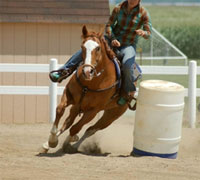 The Run Down
The Run Down
Some of today’s top barrel racers allow their horses to get away with frightening pre- and post-run theatrics simply because the horse is clocking well inside the arena. While some riders may be willing to tolerate bad behavior from the horse, out-of-control conduct can be very dangerous and is a trait frowned upon in a new prospect. It takes an advanced rider to manage the stress an unruly horse creates, and most young or novice riders haven’t yet acquired the experience necessary to deal with that aspect of barrel racing.
“Allowing your horse to behave badly just because he works well inside the arena is a bad practice,” says Powell. “This is a common problem that can start out as just getting along with him, but it blossoms into a big problem! Horses have to have a boss, or they will take advantage of your good nature.
“You’ve got to get your horse’s attention and let him know you make the decisions, not him,” she adds. “By being your horse’s boss, you help him to relax and depend on you for leadership.” Powell stresses that getting your horse’s attention doesn’t mean whipping him all the time. She acknowledges that hot-blooded horses can be hard to handle and should be dealt with carefully. “Sometimes the smarter strategy would be to stay off your horse and keep him away from the action for as long as possible, rather than trying to fight him before a run,” she says.
The Runaway
Horses that turn in amazing barrel runs seem to glide through the pattern, being controlled by only fingertip rein commands from the rider. But when some horses get into the alleyway at the end of the run, they may continue running long after the rider has signaled a stop command. The runaway may keep on running up to a fence, wall or truck, then turn sharply and surge forward in another direction. He may even run until he reaches a group of horses, or more dangerous, a group of people. Each scenario poses a serious danger to the rider, the horse and any unwitting spectator who happens to get in the horse’s path. This behavior must be corrected immediately.
“I’ve never owned a horse that won’t stop after a run,” says Powell. “Most of mine require me to push them across the finish line! Horses are creatures of habit, so if riders are intimidated by their horse and don’t assert a stop command at the finish, they are training their horse to not stop.
“I recommend that riders use plenty of bit in a run, especially on a stronger horse. At my clinics, I will set a tire out just past the time line and instruct riders to get their horse stopped by that point. It’s a matter of being focused and executing discipline,” she explains.
“But don’t just put another bit on the horse and think that will solve all your problems,” Powell continues. “You have to understand what each bit does and how it works on your horse. If you don’t understand bits and how to pick the right one for your horse, ask someone with more experience.”
Trickle-Down Stop
While Powell believes in using more bit on a horse that needs the stop command reinforced, she routinely uses a training technique she calls a “trickle-down stop” to communicate to her horse what she’s asking. Plus, an added benefit of the exercise is that it helps communicate rate to a horse when preparing to turn a barrel.
Moving parallel to the fence at a walk, sit down in your saddle and ask your horse to stop by saying “whoa” and pulling gently on the bridle reins. Once your horse has come to a full stop, reward him by allowing him to stand for a moment. When he has relaxed and is standing quietly next to the fence, gently pull on the inside rein and ask him to reverse direction by turning in toward the fence. This will teach your horse that the stop maneuver he performed will be followed by a turn. By saying “whoa” and allowing him to rest a moment before turning to the fence, you are also rewarding his correct behavior. He will soon learn to listen to your cues as a way of staying focused on his job.
The trickle-down stop will encourage your horse to have his body in the proper position—shoulders up, hindquarters engaged—before turning to the fence to switch directions. Eventually your horse will learn that when you say “whoa” at a barrel during a run, he should engage his hindquarters before initiating the turn.
“In essence, I use a trickle-down stop on the fence at approximately a 45-degree angle to the rail. After my horse is fully stopped, I let him relax for an instant, rewarding him by the release of pressure, and then I reverse him toward the fence to show him why we stopped—to turn. I believe that my horses will give me more in a clutch situation if I am gentler with their bodies by teaching them to stop easier. Plus, the trickle-down stop is similar to the collection I ask from the horse when I rate him going into a turn.”
According to Powell, getting horses to execute maneuvers because they want to, not because they fear retribution, goes a long way in establishing trust between horse and rider. If you teach your horse what you want in a way that reinforces a good relationship between the two of you, he will come to look forward to the interaction. Learning to be smart about how you teach lessons to your horse builds his confidence when he executes new techniques.
The Balker
Another habit many barrel horses pick up is balking in the alleyway, refusing to enter at the beginning of a run. While this habit’s origins are hard to identify, it is crucial to your success inside the arena to fix the problem. The alleyway is a common part of most arenas. As you wait your turn to compete, you may tense your body in anticipation. The horse feels your tense leg muscles and may start to get excited, too. As you gather the reins to make your way toward the arena, your horse may feel how nervous you are and act accordingly. Or, the alleyway may be the place where you jazz your horse up, letting him know it’s time to run. Whatever the cause, the alleyway can become a scary place to your horse. It’s very important to keep him calm and quiet, and never let him get to the point where he dreads or avoids the alleyway. According to Powell, there are several ways to break the cycle of anxiety your horse may have developed about the alleyway.
“First of all, I would try to develop a practice routine at home that includes some slow work to keep my horse calm,” says Powell. “When he is calm at home, I would take that practice routine to the rodeo arena where I can try to practice relaxing him before I run. Working on a horse’s anxiety levels in a quieter arena helps get him into the routine of going into the competition arena. Having a friend ride to the arena with you on another horse that is calm can help give your horse confidence to go into the alleyway.”
Another way to keep your horse from getting anxious about the alleyway is to follow cattle out of the arena; most facilities are set up so cattle exit through the alleyway. Allowing your horse to fall in behind a cow as it makes its way out of the arena gives him something to focus on (the cow), and he learns to go in and out without being nervous. If your horse performs other duties in the alleyway, he will be less likely to be fearful of that area when it’s time for the competition.
If your horse causes chronic problems in the alleyway, the important thing is to keep him moving forward and never let him stop, even if that means moving forward in a direction opposite of the arena. Keep advancing him forward, and maneuver his position until he is heading toward the alleyway.
Training the Young Horse
For Powell and many other barrel racers, the early years of a horse’s career are critical to success later down the road. A horse that is taught how to properly stop, back up, sidepass, change leads and maneuver obstacles with either direct or indirect rein commands is a horse that will likely have a long-lasting career. It also improves the odds that he can be successfully ridden by different riders over the course of his lifetime.
“Basic horsemanship is essential to barrel racing. If someone told me they wanted to do well in barrel racing and they only had one year to do it, I would tell them to spend 11 months working on horsemanship and the remaining month working on barrel racing,” Powell says. “Riders cost themselves time and heartache if they don’t pursue basic horsemanship before attempting to win in the arena. The lack of horsemanship actually helps to create bad behaviors that develop in barrel horses.”
If you are having difficulty getting your wild barrel horse to enter the arena or stop on command at the completion of a run, you may need to brush up on basics that dictate how much control you have over him. When you establish that you are the boss and your horse works for you, the alliance you form can take you to the winner’s circle. If your horse’s temper tantrums have become more of a production than the actual barrel racing performance, it may be time to review your riding program and go back to the basics.
Further Reading
Rating Your Run
Barrel Essentials
Seven Habits of Highly Effective Barrel Racers
Julie Wells is a freelance writer and avid cutting competitor who lives in Boyd, Texas.
This article originally appeared in the January 2009 issue of Horse Illustrated. Click here to subscribe.

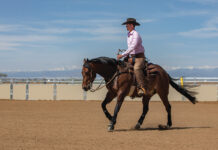
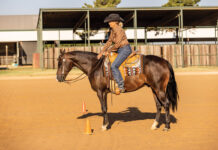
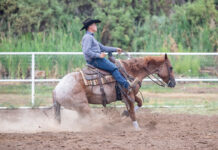

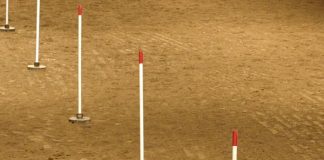

i love this sport!!!!! so fun to watch and do!
I ride a haflinger horse that is so full of energy at first it was hard to control her. no I only have to do a few sound and hand aids to control her. she does balk at the gate and me and my trainer have been trying to fix it. anybody have any ideas on what I could do?
At rodoes I cannot get her to go in the arena, I try backing her up, getting off and walking her, whipping her, nothing seems to work. How ever when we practice she has no problem going in. How can I fix this so I can continue racing on her ?
We have a 9 year old mare that started giving us some trouble around December. Initially, she was always calm at the gate and never seemed nervous. It first started as a deep first barrel and then it turned into popping out of the first barrel. We changed the saddle because we thought that was the problem due to knots on her withers. The saddle just didn’t fit her well. Things were OK for a while until the same issues began to occur, and she started fighting in the alleyway and refusing to go in the gate. We have had her looked at by 2 different vets. Both say her right hock shows some arthritis, but nothing warranting an injection. One of them said the stifle looked more short and sore than anything, but it didn’t seem to be a necessity to inject it. She told us she wouldn’t feel comfortable taking our money knowing that it didn’t have to have the injection. Anyway, we decided to go ahead and inject her. About 3-4 weeks later, her loping pattern looked much better and she worked perfect just loping through the pattern and breezing through, not asking anything more of her. The first night back at a rodeo about 5 weeks post injection, she refuses to go in the gate and she popped out of the barrel again. Now, looking back on this week prior to the rodeo, I noticed that she was making a hard right and stopping during her warm up while loping to the right. She never did this to the left. We just assumed that it was the harsher bit that we were using to keep her calm and not want to run.we are at a loss. What do the fellow horse riders think? Inject hocks, something else wrong?? Again, all the problems are only on the right side.